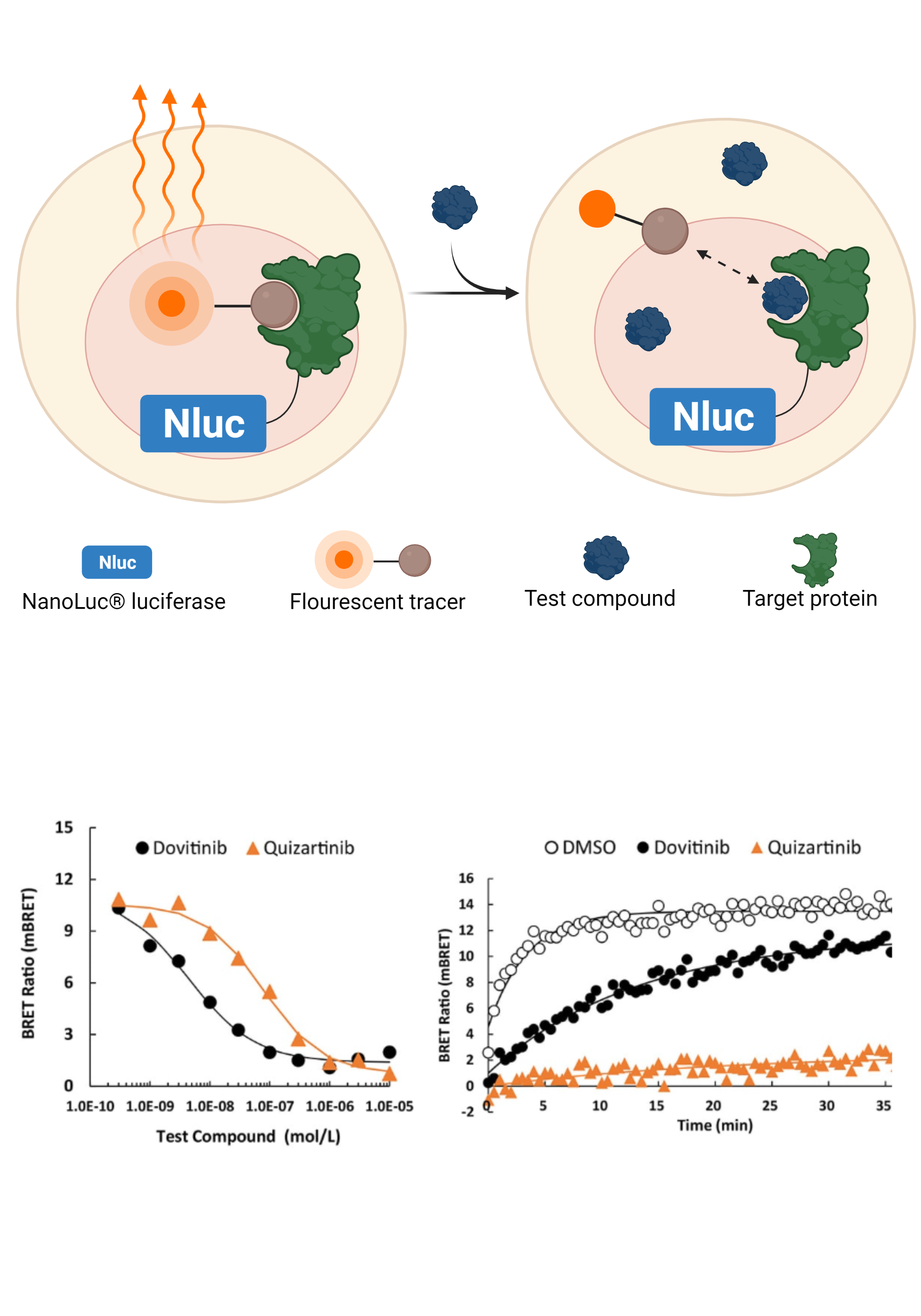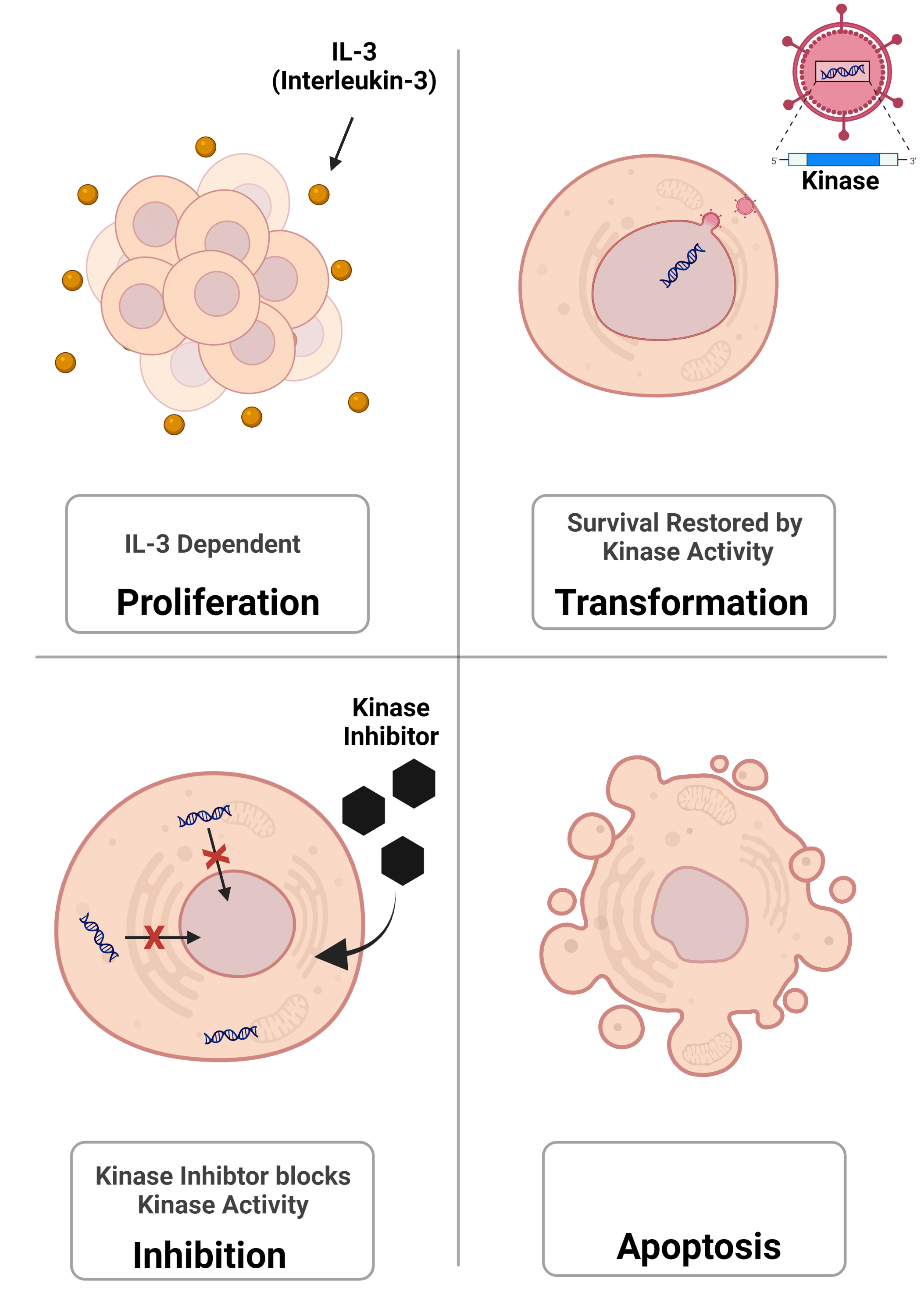Services
Cell-Based Kinase Screening/Profiling Assay Services
Once compounds are identified, Mechanism of Action studies are necessary to characterize and compare the potential drug candidates. In cooperation with Carna Biosciences and Advanced Cellular Dynamics we offer cellular kinase assay services for assessing the potency and selectivity of your compounds. Our assays comprise a tyrosine kinase assay panel and a cellular phosphorylation assay suitable for tyrosine as well as serine/threonine kinases.
NanoBRET™ TE Intracellular Kinase Assay (HEK293 cells)
Investigate Inhibitor Binding and Residence Time in Intact Cells Expressing Full-length Human Kinases
Quantifying kinase inhibitor occupancy, selectivity, and affinity within the cellular environment, where engagement would naturally occur, is crucial to predict its engagement potencies more accurately against human kinases. In addition to equilibrium evaluation, obtaining kinetic parameters such as Residence Time is desirable, enabling better compound optimization.
Quantitative and wide-spectrum kinase profiling services using the NanoBRET™ Target Engagement Intracellular Kinase Assay System (Promega) enable you to assess your compound's engagement for a selected intracellular target under physiological conditions, including compound Residence Time at the target, while keeping the cells intact. The NanoBRET™ Assay Service is provided and performed by Carna Biosciences while Kinase Logistics acts as a distributor. Simply submit your compound(s) of interest, and Carna will rapidly deliver cellular IC50 values and Residence Time!
This proximity-based assay detects molecular interactions in live cells by measuring energy transfer from a bioluminescent protein donor (NanoLuc® luciferase) to a fluorescent probe (NanoBRET™ tracer). The NanoBRET™ TE Assay measures the apparent affinity of test compounds by competitive displacement of the NanoBRET™ tracer, reversibly bound to a NanoLuc® luciferase-kinase fusion protein expressed in live cells. A cell-permeable fluorescent NanoBRET™ tracer, a BRET acceptor, is added to HEK293 cells expressing a full-length kinase/NanoLuc® fusion protein. Engagement of the tracer to the target protein generates a BRET signal. Binding of the test compound to the target protein results in a loss of BRET signal between the target protein and the tracer inside intact cells.
Panel Services
Links & Downloads

Tyrosine Kinase Cell-Based Assays (BA/F3 cells) IC50 Determination / %Inhibition Study
In cooperation with Advanced Cellular Dynamics (ACD, Seattle, WA, USA) we offer unique cell-based tyrosine kinase assay panel. This service provides tyrosine kinase profiling and screening using transfectants in which activated recombinant kinase are expressed and may help you to discover direct inhibitors to target tyrosine kinases.
The assay relies on constitutively activated kinases providing cytokine-independent growth to IL3-independent Ba/F3 (Pro-B) cell line. The cells are transformed by inducing target genes via viral vectors. Activity of the transformed kinase overrides IL-3 dependency for cellular proliferation and survival. If the kinase inhibitor (compound) specifically blocks the activity of the recombinant kinase, the modified cells undergo programmed cell death (apoptosis), resulting in a lower measurement of residual ATP.
Two Options for Activity and Potency Assessment
- IC₅₀ Determinations: ten (10) serial concentrations (9 half-log dilutions) tested in duplicate
- % Inhibition Study : three (3) serial concentrations (2 full-log dilutions) tested in duplicate
Largest Commercially Available Tyrosine Kinase Cell-Based Panel
Select your targets from the tyrosine kinase panel and % inhibition or IC₅₀ determination studies will be performed using your compounds, and clinically relevant kinase inhibitors.
In addition to screening/profiling services, provision of cell lines is also possible. For detailed provision conditions, please contact us.
Links & Downloads

Protein-Protein Interaction Detection Assay
Our split luciferase complementation assay utilizing a unique luciferase derived from Pyrearinus termitilluminans (Emerald Luciferase, E-Luc) is a valuable tool for your study of Protein-Protein Interactions (PPI). This enables the detection of various types of PPIs, including GPCRs, with ease and high sensitivity. In addition to established cell lines on the list, we develop custom stable transfected cell lines suitable to detect specific PPIs of your interest! All cell lines are available for immediate shipment after receiving your order and undergoing our quality check. We also develop transfectant cell lines that are suitable for custom assay on a fee-for-service basis. The cell assay reagent (Split Glow) will be included with each purchase of a stable cell line.
Split Luciferase Technology
E-Luc is known to emit a brighter and more stable signal than conventional firefly luciferases. The N- and C-terminal domains of luciferase can be separated into two fragments, which can re-associate in cells. When those two fragments of the fused reporter proteins are brought within proximity, they spontaneously refold and generate a detectable signal (patent filed).
Application for GPCR
The N-terminal and C-terminal fragments of the split luciferase are fused to β-arrestin and GPCR, respectively. The binding of a ligand to GPCR triggers phosphorylation of the GPCR, thereby inducing its interaction with β-arrestin. This interaction brings the N-terminal luciferase into proximity with the C-terminal luciferase, and bioluminescence activity is measurable.
We can develop transfected cell lines not listed on the Stable Cell Line List upon request.
RAF Dimerization Custom Assay Services
The impact of your compounds on any or all of the five isoform pairs, BRAF/BRAF, BRAF/BRAF[V600E], CRAF/BRAF, CRAF/BRAF[V600E], CRAF/CRAF, can now be interrogated using our RAF dimerization assay individually customized to meet your investigation. Evaluation of RAF dimerization promoted by an inhibitor provides clues for understanding the mechanism of inhibitor-induced dimerization. Quantifying the inhibitory activity of your compounds in an assay where RAF dimerization is induced by a ligand is also possible.



